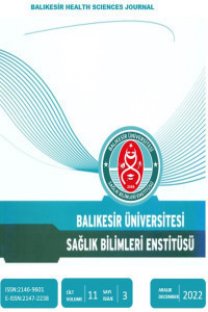Ebelik ve Hemşirelik Öğrencilerinin Mülteci/Sığınmacı Hastalara Bakım VermeSürecinde Yaşadıkları Sorunlar ve Sözsüz İletişime Yatkınlık Düzeyleri
Problems Experienced by Midwifery and Nursing Students in the Process of Giving Care to Refugee/Asylum Seeker Patients and Levels of Non-Verbal Communication
___
- Akkoç, S., Tok, M., & Hasıripi, A. (2017). Mülteci ve sığınmacı hastalara sağlık hizmeti sunulurken sağlık çalışanlarının yaşadığı sorunlar. Sağlık Akademisyenleri Dergisi, 4 (1), 23–27.
- Ayar Kocatürk, A. (2019). Göç ve Ebelik Öğrencilerinin Yaşadığı Güçlükler. In 6. Uluslararası 10. Ulusal Ebelik Öğrencileri Kongresi Tam Bildiri Kitabı (pp. 77–83).
- Aygün, O., Gökdemir, Ö., Bulut, Ü., Yaprak, S., & Güldal, D. (2016). Evaluation of primary health care services which is provided to refugees within a public health center. Turkish Journal of Family Medicine and Primary Care, 10, 6–12. https://doi.org/10.5455/tjfmpc.199143
- Barın, H. (2015). Türkiye’deki Suriyeli kadınların toplumsal bağlamda yaşadıkları sorunlar ve çözüm önerileri. Göç Araştırmaları Dergisi, 2, 10–56.
- Başol, E. (2018). Hasta ile Sağlık Çalışanları (Doktor ve Hemşire) Arasındaki İletişim Sorunları ve Çözüm Önerileri. International Anatolia Academic Online Journal/Social Science Journal, 4 (1), 76-93.
- Başterzi, A. D. (2017). Mülteci, sığınmacı ve göçmen kadınların ruh sağlığı. Psikiyatride Güncel Yaklaşımlar, 9 (4), 379-387. https://doi.org/10.18863/pgy.280392
- Ceylan Polat, D., & Akcan, E. (2016). Hemşirelik Öğrencilerinin Yabancı Uyruklu Hastalara Bakım Vermede Yaşadığı Güçlükler. Anadolu Hemşirelik ve Sağlık Bilimleri Dergisi, 19, 9–13.
- Domingo Puiggros, M., Figaro Volta, C., Loverdos Eseverri, I., Costa Colomer, J., & Badia Barnusell, J. (2008). Immigrant pregnancy and neonatal morbidity. An Pediatr (Barc), 68 (6), 596-601.
- Dotevall, C., Winberg, E., & Rosengren, K. (2018). Nursing students’ experiences with refugees with mental health problems in Jordan: A qualitative content analysis. Nurse Education Today, 61, 155-161. https://doi.org/10.1016/j.nedt.2017.11.025
- Erkuş, A., & Günlü, E. (2009). İletişim tarzının ve sözsüz iletişim düzeyinin çalışanların iş performansına etkisi: Beş yıldızlı otel işletmelerinde bir araştırma. Anatolia: Turizm Araştırmaları Dergisi, 20 (1), 7–24.
- Fassaert, T., Hesselink, A. E., & Verhoeff, A. P. (2009). Acculturation and use of health care services by Turkish and Moroccan migrants: a cross-sectional population-based study. BMC Public Health, 9 (1), 332.
- Gümüş, G., Kaya, A., Yılmaz, S. G., Özdemir, S., Başıbüyük, M., & A.M., C. (2017). Suriyeli mülteci kadınların üreme sağlığı sorunları. Kadın Sağlığı Hemşireliği Dergisi, 3 (1), 1–17.
- Gürbüz, S., & Duğan, Ö. (2017). Sığınmacılarda sağlık iletişimi: Suriyeli öğretmenler üzerine bir çalışma. Uluslararası Hakemli Sosyal Bilimler E-Dergisi, 64, 476-490.
- Hadımlı, A., Çakır Koçak, Y., Şener, A., & Üredi, N. (2019). Ebelik Öğrencilerinin Klinik Uygulamaları Sırasında Mülteci/Sığınmacı Kadınlarla İletişimde Yaşadıkları Güçlükler. In 6. Uluslararası 10. Ulusal Ebelik Öğrencileri Kongresi Tam Bildiri Kitabı (pp. 571–575).
- Kartal, B., & Başçı, A. G. E. (2014). Türkiye’ye yönelik mülteci ve sığınmacı hareketleri. Celal Bayar Üniversitesi Sosyal Bilimler Dergisi, 12 (2), 275-299.
- Korkmaz, A. Ç. (2014). Sığınmacıların sağlık ve hemşirelik hizmetlerine yarattığı sorunlar. Sağlık ve Hemşirelik Yönetimi Dergisi, 1 (1), 37–42.
- Kördeve, M. K. (2017). Suriyeli Mültecilerin Sağlık Hizmetlerine Erişimi: Bir Alan Araştırması. Sağlık Yönetimi Dergisi, 1 (2), 1-12.
- Önal, A., & Keklik, B. (2016). Mülteci ve Sığınmacıların Sağlık Hizmetlerine Erişimde Yaşadığı Sorunlar: Isparta İlinde Bir Uygulama. Süleyman Demirel Üniversitesi Vizyoner Dergisi, 7 (15), 32-148.
- Onay, M., Süslü, Z. H., & Kılcı, S. (2011). İletişim tarzının ve sözsüz iletişimin çalışanların iş performansına etkisi: Posta dağıtıcıları ve hemşireler üzerine bir araştırma. Organizasyon ve Yönetim Bilimleri Dergisi, 3 (1), 57-66.
- Paksoy, H. M., Koçarslan, H., Kılınç, E., & Tunç, A. (2015). Suriyelilerin Ekonomik Etkisi: Kilis İli Örneği. Birey ve Toplum Sosyal Bilimler Dergisi, 5 (1), 143-174.
- Parlayan, M. A., & Dökme, S. (2016). Özel hastanelerdeki hemşire ve hastaların iletişim seviyelerinin değerlendirilmesi: Bir hastane örneği. KSÜ Sosyal Bilimler Dergisi, 13 (2), 265-283.
- Penpece, D., & İnan, H. (2012). Hizmet Sektöründe Sözsüz İletişim Algısı Üzerine Ampirik Bir Çalışma. Çağ Üniversitesi Sosyal Bilimler Dergisi, 9 (1), 66-83.
- Richmond, V. P., McCroskey, J. C., & Johnson, A. D. (2003). Development of the Nonverbal Immediacy Scale (NIS): Measures Of Self- And Other-Perceived Nonverbal Immediacy. Communication Quarterly, 51, 502-515.
- Sever, H. (2012). Sosyal Öğrenme Teorileri Işığında Yasadışı Göç ve Etkileri, Dumlupınar Üniversitesi Sosyal Bilimler Dergisi, 32, 53.
- Şimşek, Z., Doğan, F., Hilali, N. G., & Özek, B. (2015). Bir il merkezinde yaşayan 15-49 yaş evli Suriyeli kadınlarda üreme sağlığı göstergeleri ve hizmet ihtiyacı. In 18. Ulusal Halk Sağlığı Kongresi (Kongre Kitabı). (pp. 998-999.).
- Topçu, S., & Başer, A. (2006). Göç ve sağlık. C.Ü. Hemşirelik Yüksekokulu Dergisi, 10 (3), 37–41.
- Tosun, B., & Sinan, Ö. (2020). Knowledge, attitudes and prejudices of nursing students about the provision of transcultural nursing care to refugees: A comparative descriptive study. Nurse Education Today, 85, 1042942. https://doi.org/10.1016/j.nedt.2019.104294
- ISSN: 2146-9601
- Yayın Aralığı: Yılda 3 Sayı
- Yayıncı: BALIKESİR ÜNİVERSİTESİ
Hemşirelik Öğrencilerinin İyi Ölüme İlişkin Düşünceleri
Banu ÇEVİK, Elif ÜNLÜ, Esin AYIK, Hilal AYTEK, Esmanur ÖZÇELİK, Gizem SAR
Merve ŞAHİN, Cihan KOCAİRi, Fatma DEMİRKIRAN
Hormonlar ya da Hormon Benzeri Maddeler ve KalıntılarınınVeteriner Hekimliğindeki Önemi
Hasan SUSAR, Murat ÇELEBİ, İzzet KARAHAN
Endoskopik Retrograd Kolanjio-Pankreatografi İşleminde Hemşirenin Rol veSorumlulukları
İnfertil Kadınların “Kadın Olma”ya İlişkin Tanımları ve Görüşleri: Bir Nitel Araştırma
Kamile KABUKCUOĞLU, Ayşe DELİKTAŞ DEMİRC
Yaşlıların Bakımında Erkek Bakıcılar: Kocalar, Oğullar
Hemşirelik Sınıflama Sistemlerine Göre Ağız ve Diş Sağlığı Hizmetlerinde HemşirelikSüreci
Doğum Öncesi Eğitimin Doğum Sonu Yaşam Kalitesi Üzerine Etkisi
PKOS Hastalarında Yüksek Kan Basıncı Sıklığı ve Bunun Klinik ve LaboratuvarParametrelerle İlişkis
